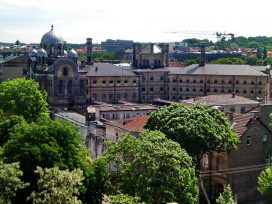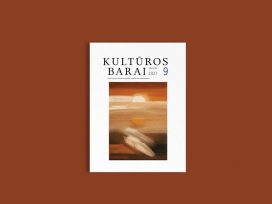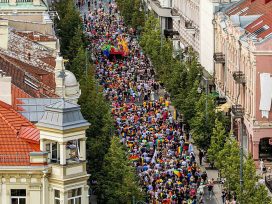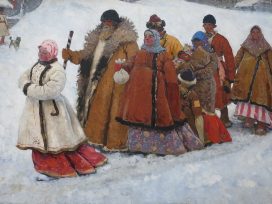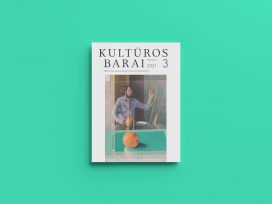In the beginning was the void. When Lithuania gained independence from the Soviet Union in 1991, 50 years had passed since the murder of over 150 000 Lithuanian Jews under Nazi occupation. Their physical destruction was followed by the eradication of their memory under Soviet rule. There was little left of Jewish Vilnius, which had been known as the “Jerusalem of the north”, or of Jewish Kaunas, which had been a centre of rationalist Talmud scholarship. In 1949, the Jewish museum in Vilnius, the only one in the Soviet Union, was closed, and several years later, the Yiddish primary schools in Kaunas and Vilnius were also shut down. The Soviet Union remained silent about the Holocaust as a Jewish tragedy and propagated anti-Zionist and even partly anti-Semitic stereo-types. Thus, the Yiddish inscription on the memorial at the mass murder site Ponariai (Ponary), located outside Vilnius, was changed in 1949: the new inscription, in Russian and Lithuanian, commemorated the massacre of “Soviet citizens”.
The remaining traces of Jewish culture were forgotten or erased. The Soviet authorities allowed old Jewish graveyards to fall into disrepair; in the larger towns and cities, they destroyed Jewish cemeteries and used the tombstones for construction material. The Great Synagogue in Vilnius, whose roof had been destroyed by fire, was abandoned to the elements. Eventually, the authorities tore it down, in order to build a nursery school on the site – a symbol of the Soviet Union’s bright fu-ture. A palace of sports and culture was built on the site of the once famous Jewish cemetery in the Snipiskes district of Vilnius. The cemetery had been closed in the tsarist era, but had survived the Second World War unscathed. Only the remains of the most famous dead, such as the Gaon of Vilna, Count Walentyn Potocki, and some of the more famous leaders of the Bund (the General Jewish Workers Union in Lithuania, Poland and Russia), were transferred to the Jewish cemetery on Suderve Street. The grave of the Gaon of Vilna was then brought to the Jewish cemetery in Uzupis in 1953, where it remained until this graveyard was also demolished in 1968. After the war, almost all of the surviving synagogues were turned into warehouses, school sport halls, and shops. Only in Vilnius, Kaunas, and Plunge were synagogues al-lowed to remain open for a while.
The Soviet authorities removed Yiddish inscriptions from houses and tore out the mezuzahs, the traditional parchment cases that usually hung on the doorposts of Jewish shops and workshops. At the sites where mass shootings of Jews had occurred, commemoration plaques with the following inscription were introduced: “At this place, the Hitler-occupiers and their volunteer helpers – the bourgeois nationalists – shot and killed Soviet citizens.” At the time, everybody knew that these Soviet citizens were primarily Jews, and that the “bourgeois nationalists” were primarily Lithuanians. By the end of the 1950s, little was left to remind the population of Lithuanian Jewish life.
The search for traces
It first became possible to write about the crimes against the Jews in the 1960s. In 1960, journalist Stasys Bistrickas published a small volume titled Ir susaudytieji prabyla [And those who were shot bear witness] about “the crimes of the Hitler-occupiers and the bourgeois nationalists in Ponary”. This was followed by the document collection “on the trials against Lithuanian war criminals held in Vilnius and Kaunas in 1962”. These trials were held at the same time as the trial of Adolf Eichmann in Jerusalem and were extensively covered in the Soviet press. The case in Israel was not ignored in Lithuania either. The diary of Masha Rolnikaite, a “former inhabitant of the Vilnius ghetto and Concentration Camp Stutthof”, was published in 1963, and in 1967, there appeared Sofia Binkiene’s book Ir be ginklo kariai [War without weapons], which dealt with those who rescued Jews. This was followed in 1969 by a work by Meiris Eglinis-Elinas and Dimitrius Gelpernas on resistance in the Kaunas ghetto. The year 1965 saw the publication of the first part of a harrowing two-volume collection of documents that made extremely clear who the Nazis’ primary victims were. However, these books were hardly read in Lithuania, as they came with forewords and commentaries laden with Communist ideology. Soviet propaganda equated Nazi collaborators with supporters of an independent Lithuanian state and portrayed “bourgeois Lithuania” as a loyal accomplice of Fascism.
The Soviet authorities soon allowed this rivulet of commemoration to run dry again. After the emigration of many Jews to Israel, which began in the early 1970s, secret orders were issued to remove a number of books from Lithuanian libraries and bookshops. These included auto-biographical sketches by Mejeris Elinas-Eglinis, the works of Icchokas Meras, which were published throughout the Soviet Union, and the poetry collections of Hirsh Osherowicz. They were replaced by a del-uge of propaganda pamphlets against Israel and Jews seeking to emi-grate. Prominent personalities of Jewish origin, such as sports journalist Saliamonas Vaintraubas or Volfas Vilenskis, who had been awarded the title “Hero of the Soviet Union” for his military service during the Second World War, had to sign public declarations against alleged Zionist warmongering.
One genre that made Holocaust remembrance possible was the memoir literature written by some Jewish authors. However, these memoirists came exclusively from the ranks of the Communist Party, the Commu-nist youth organisation Komsomol, or other Soviet organisations, or they had served in the 16th Rifle Division, were former partisans or members of the Red Pioneers before the war. Masha Rolnikaite, in her portrayal of the Vilnius Ghetto underground, writes exclusively about Communists and Komsomol’ members. She does not say a word about Bundists, Zionists, or the representatives of other parties who had come to together to form a united underground organisation.
It was a similar story in film: Two films with clear references to the Holocaust – Zingsniai nakti [Footsteps in the night] by Raimundas Vabalas from 1962, about the escape of Jewish prisoners from the concentration camp Fort IX near Kaunas, and Ave, vita! by Almantas Grikevicus from 1969 – deal with opposition to the Nazis without mentioning the heroes of Jewish background. The fact that Jews were only discussed if they were Communists only fuelled the anti-Semitic stereotype that all Jews were Communists. This perception was strengthened by an expansion of the definition of “participants in the revolutionary struggle” to include all leftwing youth. As a result, Soviet-era Lithuanian encyclopaedias swarmed with Jewish names.
Euphoria and setbacks: Perestroika and its consequences
When the Lithuanian independence movement Sajudis was founded in 1988, the Soviet authorities tried to discredit its followers as radical nationalists. However, Jewish artists and men of letters – such as Emanuelis Zingeris, leader of the Jewish Cultural Association of Lithuania, and Grigorijus Alpernas, leader of the Tkuma association for the rebirth of national consciousness – published open letters in sup-port of Sajudis in 1988 and were consequently well received among the Lithuanian population. An exhibition on Lithuanian Jewish art organ-ised by Zingeris, later a member of parliament, opened in Kaunas in June 1988, just one week after the founding of Sajudis, before moving on to Vilnius. This also helped bring Jews and non-Jews in Lithuania closer together. Zingeris understood the need to make Lithuanian soci-ety aware of the rich heritage that had been lost to the destruction and repression of Jewish life in Lithuania. Lithuanians at the time saw the Jews as allies in the struggle for independence. When Lithuanian Jews founded a cultural association on 5 May 1989, the leading members of Sajudis congratulated them in person and apologised for the collaboration of their compatriots with the Nazis.
Commemoration of Lithuania’s Jewish heritage and remembrance of Holocaust victims were increasingly permitted and officially promoted as Lithuania came closer to leaving the Soviet Union. At the end of 1989, the republic’s government agreed to re-open the Jewish museum that had been closed in 1949. On 13 February 1991 – four days after its referendum on independence – the Lithuanian government decided that the scattered collections of individual Jewish museums should be turned over to the new Jewish museum. In October 1989, the Sholem Aleichem Jewish Middle School in Vilnius opened its doors. Many Jewish organisations were also founded at that time. Prime Minister Adolfas Slezevicius and President Algirdas Brazauskas made state visits to Israel in the mid-1990s. There, before the Knesset, they acknowledged the crimes committed by Lithuanians during the Second World War and asked the surviving Jews and descendents of the victims for forgiveness. However, in Lithuania itself, these apologies in the name of the Lithuanian people aroused indignation among parts of the population and some politicians.
Lithuanian independence also had its dark side. For example, all those who had been sentenced by the Soviet secret service were rehabilitated no matter the reason behind the sentence. This resulted in the rehabili-tation of a number of war criminals who had not been sentenced for participation in anti-Soviet fighting, but for participation in the mass murder of Jews under Nazi occupation. This decision was revised two years later, but the pardon brought a wave of international condemna-tion, to which Lithuania failed to respond adequately. Instead of apolo-gising to the Jewish community, many Lithuanians saw the episode as a Kremlin intrigue. Around the same time, the United States began de-porting to Lithuania US citizens of Lithuanian origin who were sus-pected of participating in Nazi crimes. Many of them had gained a good reputation in emigration; the discovery of their past was a great shock for Lithuanian society, especially within the diaspora. The case against Aleksandras Lilieikis at the end of the 1990s attracted particular atten-tion. Under Nazi rule, he had been in charge of the Vilnius district’s branch of the Saugumas – the Lithuanian security police, i.e. the Ge-stapo’s local auxiliaries. Later in the United States, he had helped pub-lish a standard reference work on Lithuanian history. The resultant in-ternational pressure – for example, from the Simon Wiesenthal Centre in Jerusalem – increased the country’s defensiveness.
At the same time, the “two genocides theory” spread from the émigré community in the United States to Lithuania. According to this theory, the Jews had collaborated with the Soviet occupiers in carrying out a genocide of Lithuanians in 1940; when Germany liberated Lithuania, Lithuanians spontaneously carried out revenge against the Jewish traitors. A prominent representative of this apologist view of history is writer Jonas Mikelinskas, who wrote an essay for the renowned Lithuanian literary journal Metai in which he claimed that responsibility for the Holocaust ultimately lay with the Jews themselves. This theory found a shockingly large number of supporters in Lithuania. The hope that Jews and Lithuanians would live amicably side by side – a hope that had seemed so promising in the early 1990s – had vanished within a decade.
Civil society awakens
The dispute over Lithuanian participation in and responsibility for the murder of Lithuania’s Jews revealed considerable potential for antisemi-tism, but at the end of the 1990s, Lithuanian society began to give a great deal of attention to its Jewish heritage and the destruction of Lithuanian Jewry. The impulses coming from society – pressure from the West did not play an important role here – were much stronger than elsewhere in eastern central Europe at the time. This was largely due to the engagement of non-state initia-tives. They recruited many volunteers, aroused the interest of politicians and authorities, built relationships with partners abroad, and worked con-structively with state and non-state institutions.
Up until the end of the 1990s, Jewish organisations, such as the Jewish Museum, the Vilnius Pedagogical University, and foreign organisations had been primarily responsible for the protection of Lithuania’s Jewish heritage. In 1999, the international Jewish organisation B’nai B’rith and the United States Holocaust Memorial Museum, with the support of the Lithuanian Ministry of Education, published a two-volume schoolbook on the Holocaust, which was distributed to schools throughout the country. However, it was hardly used, because it differed significantly from the textbooks in circulation, and because teachers were not instructed in how to apply it.
It was possible to learn from these mistakes, however. The Lithuanian teacher training centre, together with the British Holocaust education centre Beth Shalom, organised seminars for teachers. In 2001, Beth Shalom produced the two-hour film Saulelydis Lietuvoje [Sunset in Lithuania] for classroom instruction. It covered Lithuanian-Jewish culture, the Holocaust, and relations between Lithuanians and Jews. There was an accompanying teachers’ guide for the film. All over Lithuania, teachers were given seminars to show them how they might integrate the film into lessons. Since the end of the 1990s, the more Lithuanian organisations have shown an interest in rediscovering the Jewish heritage and confronting the Holocaust, the more resonance these topics have found in society.
In 2000, the association House of Remembrance was founded. It launched five history competitions on the theme “The Jews – My Grandparents and Great Grandparents’ Neighbours”. Schoolchildren from across Lithuania participated in the competitions. They recorded stories from their grandparents about former Jewish neighbours, collected historical photographs, and took pictures of houses where Jews had lived. The best pieces of work were published, and the authors invited to an awards ceremony in Vilnius. With support from the Ministry of Science and Education, the association also founded history clubs in schools, information centres, and museums, organised excursions to former concentration camps, such as Auschwitz, Stutthof, and Klooga (Estonia), and published books on Lithuania’s Jewish heritage and the Holocaust.
Working together with the Ministry of Culture, the New Education Foundation (Svietimo kaitos fondas), which was founded by the Ministry of Science and Education in 1999, organised a national competition for museums in 2001-2004. In 2001, the theme was “The History of the Holocaust in Our Region”, in 2002-2004, “The History of the Jewish Communities in Our Region”. In 2005, the foundation set up an Internet database to register Holocaust-related projects at schools, universities, museums, and other state and non-state institutions. The foundation also created an interactive map that documents approximately 200 known locations of mass murder in Lithuania.
Political education about the Holocaust is also offered by the Interna-tional Commission for the Evaluation of the Crimes of the Nazis and the Regime of the Soviet Occupation in Lithuania, which President Valdas Adamkus established in September 1998. International Jewish organisa-tions initially expressed criticism, saying that the commission’s simulta-neous evaluation of both Nazi and Soviet crimes played down the sig-nificance of the Holocaust. After noteworthy historians from the United States and Israel accepted invitations to join the commission, criticism receded.
The education programme unveiled in 2002, however, created a con-troversy that revealed the two basic tendencies in assessing the Holo-caust in Lithuania: for one group of people, working through the past is a politically motivated issue and serves above all to enhance Lithuania’s image abroad. For the others, confronting the crimes committed by Lithuanians is a moral issue.
Thus historians and multipliers who had worked for many years to get Lithuanian society to recognise the Holocaust were critical of the fact that the commission was financed by the state to conduct historical re-search, but not to promote political education. The head of the educa-tion programme, Snieguole Matoniene, also sparked controversy when she claimed that teachers took up Jewish topics “to improve their career prospects”. There was also criticism of the fact that the commission was too keen to see Lithuanian teachers and multipliers travel abroad for training courses.
People were irritated as well by the way the commission conveyed the impression abroad that work on the Holocaust was in its initial stages in Lithuania, and that current initiatives were unprofessional. The authors of a textbook on the history of Lithuania that comprehensively addressed Lithuanian collaboration with the Nazis were particularly ag-grieved. A cooperation treaty between the Lithuanian Ministry of Edu-cation and the Israeli Holocaust memorial authority Yad Vashem was met with incomprehension, as was the rush to found tolerance centres in Lithuanian schools and universities due to fears that there were not enough motivated teachers available to introduce such a sensitive issue into classroom instruction. With time, however, the positions of the parties involved converged. The New Education Foundation, together with the commission, organised a history competition in Lithuanian schools: “From Civil Initiatives to Civil Society”. Working together, the New Education Foundation, the Jewish Museum, and the Ministry of Science and Education developed a state education programme to promote learning about the Holocaust.
Despite these initiatives, Jewish heritage is still recognised as a part of Lithuanian history and culture primarily in the larger cities, especially in Vilnius and Siauliai and to a lesser extent in Kaunas. In the provinces, it is left to a handful of idealists, such as those teachers who encouraged their pupils to enter the aforementioned competitions and thus broke through the general indifference.
The Kedainiai Museum offers a ray of hope. Museum workers there have succeeded in restoring two synagogues in the old quarter of this central Lithuanian town. One of the synagogues has been turned into a cultural centre. It hosts events on Jewish history and culture, organises projects that promote tolerance, and creates teaching materials on the history of the Jews in the area around Kedainiai.
The small town of Kaisiadorys, also in central Lithuania, has been very active as well. The town museum published a book on the Jews of the Kaisiadorys region by historian Rolandas Gustaitis and helped to preserve the wooden synagogue in the nearby village of Ziezmariai. The latter was particularly important, as the Nazis burned down most of these unique wooden houses of worship. Pupils at the children’s music school in the village of Rumsiskes in Kaisiadorys district put together a programme on the Jewish community of Rumsiskes and recorded a CD Forgotten Melodies of Rumsiskes. This is the first CD of Yiddish songs performed in Lithuanian translation. With the consent of the Jewish community, the open-air ethnographic museum at Rumsiskes, which features farmhouses from all regions of Lithuania and a typical Prussian Lithuanian town, has re-built a preserved wooden synagogue in the town.
In the small towns Kalvarija and Joniskis, in southwestern and northern Lithuania respectively, synagogues are to be restored. However, many of these former prayer houses, especially those built of wood, are in poor condition. The Vilnius Art Academy and the Centre for Research into the Culture and History of East European Jews are trying to find, document, and photograph all of the surviving synagogues. The Jewish Museum and the Office for the Preservation of Cultural Artefacts, a part of the Ministry of Culture, are pursuing similar projects.
Against this backdrop, another source of optimism is the unveiling in recent years of several monuments and commemoration plaques to hon-our Jewish-Lithuanian writers, artists, and musicians. Kaunas’s Liberty Avenue (Laisves aleja), Europe’s longest pedestrian street, now has a monument to the legendary, prewar popular singer Danielius Dolskis. In Vilnius, a sculpture was erected in honour of the distinguished doctor, medical theorist, and politician Zemach Szabad, who is well-known all over the former Soviet Union as the model for the main character in the children’s book Doktor Aibolit by Kornei Chukovskii. There is also a monument to the French writer Romain Gary, who was born in Vilni-us. All three sculptures were made by Romualdas Kvintas.
Alongside the sculptures, there are countless commemoration plaques, for example, for Theodor Herzl, Joseph Brodsky, violinist Jascha Heifetz, philosopher Emmanuel Levinas, painter Rafael Khvoles, poet Moshe Kulbak, and the founder of the YIVO Institute for Jewish Research Max Weinreich.Many of these commemoration plaques were created at the initiative of Pranas Morkus, chairman of the Lithuanian-Israeli Society.
Summary
Over the last decade, Lithuanian society has begun to reflect more inten-sively on its Jewish heritage and the Holocaust, but most government officials still have very vague notions of Lithuania’s Jewish history and are unwilling to confront this history. This includes not only authorities at the local level, but the ministries of justice and culture and even the Ministry of Science and Education and the Ministry of Foreign Af-fairs.
The minds of many politicians are still awash with stereotypes from the interwar and postwar periods. They still tend to see the conservation of the cultural heritage of Lithuanian Jewry as a foreign, non-Lithuanian event, something the West has forced Lithuania to acknowledge. They do not see it as the responsibility of the Lithuanian state to restore cemeteries or synagogues or to produce commemoration plaques.
The kind of attitudes that ensured a delay in the legal proceedings against Lithuanians accused of participating in the Holocaust still exist. There should be no mistake about that. On the other hand, it is clear today that young people see the history of Lithuania’s Jews as part of Lithuanian history.
This new attitude flickers from time to time in politics as well. In June 2008, the Lithuanian government approved the construction of a new museum, which will be conceptualised in cooperation with the Hermitage in St. Petersburg and the Guggenheim Museum in New York. It is to bring not only avant-garde art to Vilnius – above all works by the Lithuanian-born American director Jonas Mekas and the musician and video artist George Maciunas (Jurgis Maciunas) – it is to include as well a section dedicated to art by Lithuanian Jews.
